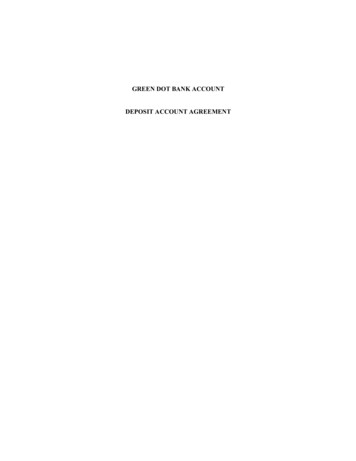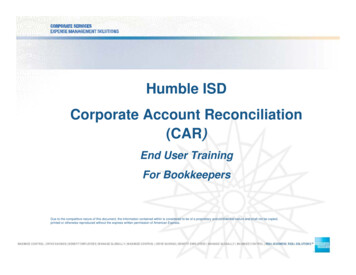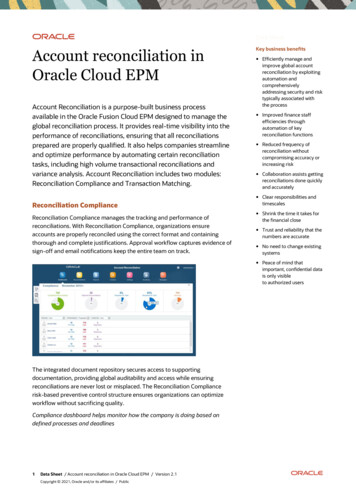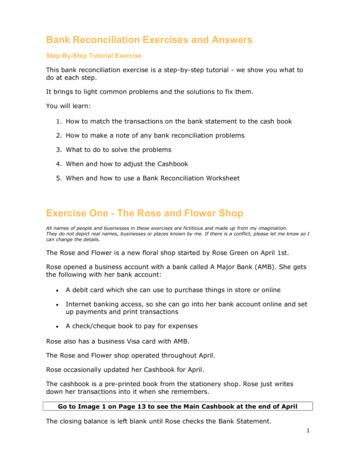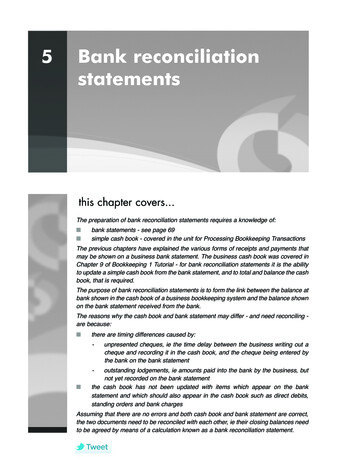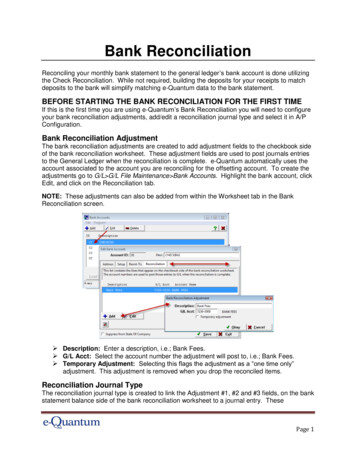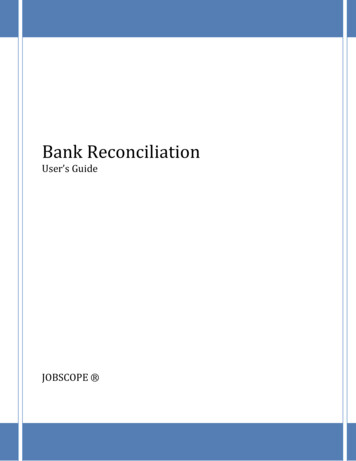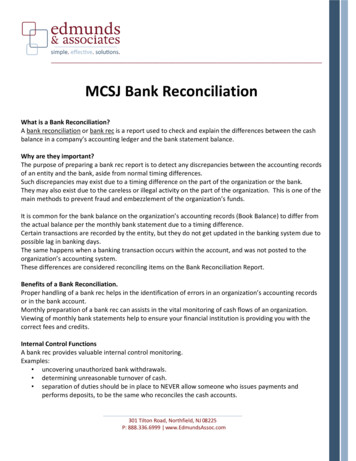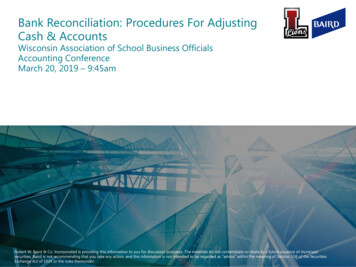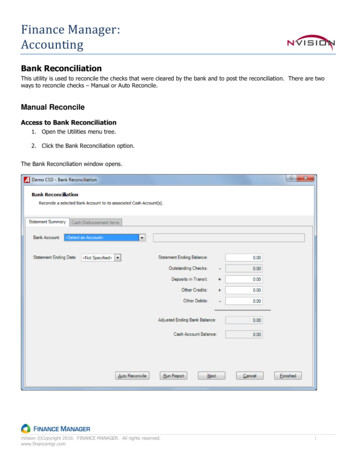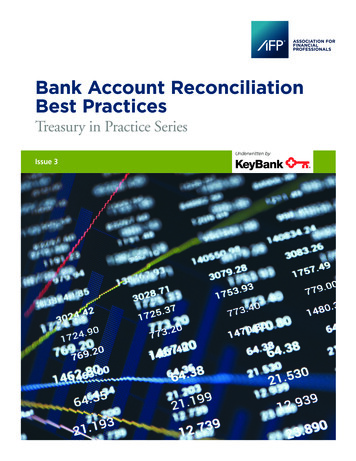
Transcription
Bank Account ReconciliationBest PracticesTreasury in Practice SeriesUnderwritten byIssue 3
Treasury in Practice: Bank Account ReconciliationBank Account ReconciliationBest PracticesTreasury in Practice SeriesAugust, 2014AFP Members and Guests:We are pleased to provide the second installment in the 2014 AFP Treasury in Practice content series. The subject of thisguide is Bank Account Reconciliation, and it provides valuable insights on account mix and structure decisions, accountlevel controls, fraud prevention and much more.KeyBank sponsors the 2014 AFP Treasury in Practice content series as part of our commitment to providing treasuryprofessionals with the latest industry insights. The series covers the latest thought leadership on important topics along withpractical information on ways to strengthen treasury operations. A total of six guides will be released throughout the year.We hope that you enjoy this installment in the series and as always, your feedback is welcome.Best Regards,Clark H KhayatEVP, Enterprise Commercial PaymentsBank Account ReconciliationBest PracticesAdvances in bank account reconciliation, along withexpansion of the types of information banks canprovide their customers, have made it much easierfor companies to match their cash accounts to bankrecords. By automating the reconciliation process,treasury can identify discrepancies quickly, free uptime to focus on more strategic issues, and bettermanage liquidity. And, by reconciling accounts daily,the monthly “hard” reconciliation becomes a mucheasier and less time-consuming process.2 2014 Association for Financial Professionals, Inc. All Rights Reservedwww.AFPonline.org
Treasury in Practice: Bank Account ReconciliationBest Practice TipsRationalize account structure. “We spent the past18 months getting our arms around how many bankaccounts are out there, and what activity takes placein each account,” said the team lead of the insurancecompany. “We’re looking at BAI files daily,” she said.Treasury takes 10-15 accounts monthly and reviewsthem at the granular level. “We look at all activity,charges, contact information, and fee agreements.”They do this in order to ensure that the right accountshave the right level of services, as well as to determineif new accounts that need to be opened or establishedaccounts need to be closed. “Hopefully we will findaccounts we can close. The goal is to reduce bank feesand to simplify reconciliation. You can’t change whatyou don’t know.”Identify Fraud. When reviewing exceptions “you needto be diligent,” said Rosenberger. “Fraud preventionis very important.” In the past, companies assumedfraud prevention was the bank’s responsibility. Shenoted that everyone who’s involved in the paymentcycle has responsibility for fraud prevention. “If youget hit, it costs both time and money,” she said. “Beknowledgeable about fraud and take advantage of theservices that are available.”Automate. “As automation gets better, companies arebecoming less reliant on their banks,” Rosenberger said.“Banks will have to produce the data companies need,whether it’s checks, ACH or wires, but clients will load thedata and do their own reconciliation within their system.That process will continue to evolve, which puts pressureon banks to supply the right data in the right format.”Identify discrepancies quickly. “The daily routine is veryimportant,” the cash manager at the Canadian companysaid. “The sooner discrepancies are discovered andresearched, the quicker they tend to be resolved.”Make it part of your routine. According to Durkin,every organization should make the reconciliationprocess part of its regular reporting and review process.“Talk to you bank about upgrading and leveraging thecapabilities of your existing TMS and/or ERP,” he said.“It’s necessary to have a dialogue with your bankingpartners about making reconciliation part of the bankpractice review and treasury scorecard.”www.AFPonline.orgOptimize account structure“The first thing to do is go through the account structure,” saidTom Durkin, managing director at Bank of America. “The key is toget clear agreement and, most importantly, to discuss how clients canmove it [account structure] toward automatic reconciliation.”It could be a physical Zero Balance Account (ZBA) structurein the United States, Durkin said, or an international notionalstructure. “There has to be an agreement between the clientand the bank in terms of where they want to go,” he said. “Theaccount structure defines how much granular detail they want andhow much data they need.”According to Rosanne Rosenberger, senior productmanager of enterprise commercial payments at KeyBank, a lotdepends on the size of the client’s organization—for example,bank account structure is more complex for largerorganizations operating in different industries or geographiclocations. The bank often works with companies to help themfigure out the right mix of accounts for their organization, aswell as to establish necessary controls for access and fraudprevention in each account.Account structure also depends on what business the companyis in. Some companies, such as real estate firms, have multiplelegal entities and corresponding accounts for each. In that case,“opening different accounts to handle different transactionsdoesn’t make sense,” Rosenberger said. “You can’t have three orfour accounts for each legal entity. The structure has to makesense for the business they’re in and what they’re trying toaccomplish as a company.”The process of bank rationalization, a process to concentrateaccounts across a smaller number of banks, can help standardizethe account reconciliation processes and lower costs, accordingto Durkin. Use of industry standard formats such as theISO 20022 XML can help further reduce the complexityinvolved in locating critical data to perform automatedreconciliation. A potential drawback is that over-consolidationof accounts limits the opportunity to enforce segregation ofaccess to account details.“In general, the fewer accounts the better,” said John Snyder, vicepresident of business development at Chesapeake System Solutions,a provider of reconciliation software. “As long as the company has away to segregate data as needed within each account.”To facilitate reconciliation, companies can consolidate theiraccounts with fewer banks and create an account hierarchy.“If you have multiple accounts, group them together,” Snydersaid. “Then take those and roll up the reconciliation; if there’sa discrepancy, companies can [more easily] drill down to thesubaccount level.” 2014 Association for Financial Professionals, Inc. All Rights Reserved3
Treasury in Practice: Bank Account ReconciliationA senior accountant and team lead for an insurance companywith 250 enterprise-wide accounts in 10-12 different banks saidher company uses ZBA accounts. “We have some money marketaccounts and separate accounts for payroll, AP, AR and credit cards.That structure evolved over time,” she said. The company is nowfocused on centralizing and consolidating those accounts, whichmay mean maintaining separate accounts for separate activities, e.g.,a disbursement account and an AR account. “But we will have oneinstead of five,” she said. “The information we can now get from thebank does not necessitate so many bank accounts.”Make reconciliation a daily taskThe most common use of the term is in reference to a periodicsettlement between the book record and the cash record. While a“hard” recon is commonly done once a month, “it’s critical thatyou keep up with daily activities and identify exceptions,” Syndersaid. “Do a mini reconciliation every day and ensure the finalsettlement syncs with the accounting period.”“Clients typically get a recon file from their bank everymonth, matching their DDA statement cycle,” said KeyBank’sRosenberger. “But I can’t stress enough that from a transactionstandpoint, no matter the payment type, reconciliation needsto happen on a daily basis.” Most banks offer online systems, so“there’s no reason not to look at posted transactions daily, evenfor a big client,” she added. For a technically sophisticatedclient, that may mean uploading a daily file and running itthrough their treasury management system (TMS) or enterpriseresource planning (ERP) system.According to Warren Davey, senior vice-president of marketingand sales at GTreasury, a treasury management system vendor,companies that reconcile transactions to the general ledger daily cansave a lot of time at the end of the month. “It’s easier to find fivetransactions a day than to find 100 at the end of the month,” he said.“You need to have a more consistent perpetual process, where you’redoing a little work every day.”“We have many conversations with treasury teams that arelooking for greater efficiency,” Durkin said. “If reconciliation canbe handled more efficiently, treasury can have the opportunityto spend more time on strategic activities versus dealing withtactical issues. It’s not the best use of their time.”Maintain adequate controlsIt’s important that companies separate the ability to transactwithin the account from reconciliation. How duties are separatedsometimes depends on company size, according to Rosenberger.“Smaller companies with less staff find it harder to separateduties,” she explained. “One person could be wearing more than4one hat.” Whereas larger companies have the resources to ensuredifferent people initiate, approve, and reconcile transactions. “Somecompanies handle reconciliation within treasury while others handleit within accounting—and sometimes both,” she said.Separation of duties is a requirement for compliance withthe Sarbanes-Oxley Act (SOX). But even before SOX, mostcompanies did not have the same people creating transactionsand reconciling them. “There’s a lot of concern with securitywithin the system, and multiple authentication in terms ofsign-in and multiple authorizations and approvals,” Snydersaid. “SOX accelerated and intensified the focus on that, and it’sgrowing more and more.”With the proliferation of Automated Clearing House (ACH)transactions, there’s an increased potential for fraud as volumesincrease. “We handle that with ACH positive pay,” said Snyder.“The system looks for suspicious ACH transactions. Anotherapproach for preventing fraud is to implement account blocks. Ifit’s a depository account, block any debit transactions. Auditingfor fraud is generally done at the account level. It’s difficult toidentify fraud by going after random transactions. It’s unlikelyto provide meaningful results.” According to Snyder, mostdiscrepancies are a result of mistakes, not fraud, “but mistakes canbe pretty serious as well.”“We have 31 banks globally and approximately 230bank accounts,” said the cash manager of a Toronto-basedmultinational corporation. The company maintains separatedisbursement, collections and payroll accounts, and lockboxes,depending on the size of the office. “To a certain extent thatmakes it easier,” he said. For smaller offices, the company uses asingle account with subaccounts.To enhance controls, the company is aiming to leverageits global Shared Service Centers (SSCs). “We have an ARteam located in an SSC in Mexico that is responsible for allcollections, and an AP team in an SSC in Asia that is responsiblefor global disbursements.” The company is migratingreconciliation of accounts from site controllers to the SSCs.Right now, site controllers are responsible for reconciliation(the process is automated through an auto-feed into SAP) butare unable to “touch” the accounts. That activity is centralizedwithin corporate treasury at headquarters or regional centers.While the SSC will handle the monthly G/L reconciliation,treasury does a daily cash recon to match in-flow and outflowsthrough the TMS for liquidity planning purposes.At the aforementioned insurance company, cash accountingis a separate function within treasury, and corporate accountinghandles the monthly book/cash reconciliation. “SAP reallychanged how we reconcile accounts,” said the senior accountant 2014 Association for Financial Professionals, Inc. All Rights Reservedwww.AFPonline.org
Treasury in Practice: Bank Account Reconciliationand team lead. “We get a BAI file and reconcile on a daily basis.”The company has 60 field offices, some of which hold accountswith small banks that still issue paper statements. For these fieldoffices, reconciliation is performed monthly.According to Snyder, another approach to separation of dutyis to outsource the recon process to banks, especially for smallercompanies with limited staff, those that don’t have enough staffto segregate the duties effectively. When outsourcing to a bank,the company provides transactional data (“the book side”) via afile transmission format, and the bank does the record-to-cashreconciliation. “The bank takes care of everything,” Snydersaid. “Once the bank has the book side from the customer,they take care of matching and researching discrepancies andcommunicate back any exceptions. The banks are very interestedin this fee-based service—and it benefits the company,” whichends up only working the exceptions and thus finding moreproductive ways to spend their time.Seek automated solutionsAutomation is critical to shortening reconciliation time. It alsoallows companies to keep track of transactions on a daily basis.“Without a system, that’s very difficult,” Snyder said. If softrecon is not performed daily, the exceptions show up at the endof the period and accumulate over time.“Spend a little bit of time each day on eliminating exceptions,”Snyder said. “This way you’re not trying to do it all at once anddealing with something that happened three weeks ago.” Bydoing matching, exception identification and research daily, theend-of-month reconciliation process goes much quicker. “Allyou’re doing is recording the final results,” said Snyder.With an automated environment, companies spend 99.99percent of t
Treasury in Practice an Accont Reconciliation Bank Account Reconciliation Best Practices Advances in bank account reconciliation, along with expansion of the
